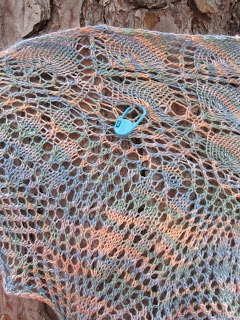As in all new projects, my enthusiasm was a tad more than my skill or ability but charge ahead I did.
First I needed to select a yarn. I had a skein of fingering weight yarn from Schaefer Yarn in the Aung San Sui Kyi color... a luscious colorway of peach, green and blue in 50% merino wool and 50% silk called Audrey. I had intended this yarn for some special socks but a lacy shawl seemed like a better project for this yarn.
Secondly I needed to find a pattern. Since I had 700 yards of Audrey I figured I would have a lot of choices. WRONG! It seemed that most of what I liked either required thousands of yards for a body covering shawl or only about 400 yards for a little neck cover. I needed something in between and ended up selecting a free pattern on Ravelry called Ethereal Shawl and originally published on the Patterns From my Head blog. There were options included in the pattern for using more or less yarn than the original. The best part about this pattern is that it has been tested and the pattern updated several times so any errors/discrepancies in the original pattern have been solved.
I printed off a couple of copies of the pattern, sat down with my needles and cast on assuming I would be finished in a couple of days. Almost a week later I was still casting as I ripped out the first few rows about 20 times before I got into the rythym of the pattern. As I continued to knit I found that I had a lot of trouble counting my pattern stitches, keeping my place in the pattern and at about 75% complete I found that I had dropped a sticth or two way down int he middle of the pattern.
Here's how it turned out:
Here's where I dropped a stitch or two. Still don't know how I going to fix it but I will...even if it means just threading the loose stitches on a piece of yarn and tying it off in a big honking knot!
I am not unhappy with the result as it fits around my shoulders and is light enough to not be oppressive but heavy enough to provide some protection against air conditioning.
There are a lot of lessons learned in this project.
- Have lots and lots of stitch markers when doing doing multiple repeats of the same pattern in a row. I used over 20 per row by the end, and although it looked like it was raining stitch markers every time I stood up, they made a huge difference in keeping track of the pattern. I did not learn this until about 30 rows from the end.
- Count every pattern repeat and every row at least twice. Just because you got the right answer on the first count, count again just to be sure.
- A variegated yarn like I used is beautiful and hides flaws but a solid yarn would have highlighted the pattern better.
- Stitch markers are not all alike. Those made out of rings with a little space for opening them up love to catch extra yarn especially when using such fine yarn. Look for stitch markers when the ring does not have a little gap in the ring. This is not a good marker...see the little gap in the ring? While these and these look great. Most of my stitch markers have the split so i was not a happen camper.
- Make many copies of the pattern you are using. I ended up destroying three copies with my notes and marks. I still have one copy in pristine condition so I can always try this again.
- Use the recommended size of needles. Do not assume you know better, you probably don't.













